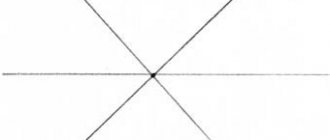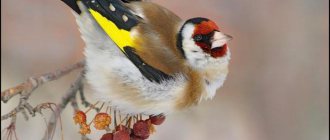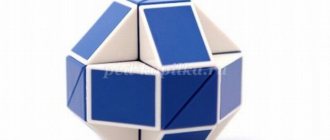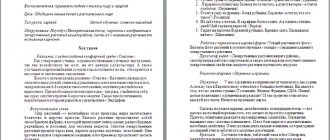Summary of a lesson in kindergarten in the middle group on the topic: “Nature in human life”
Lesson in the middle group on the topic: “Nature in human life”
Goal: to develop knowledge about the importance of nature in human life Objectives: Educational:
1. To form an idea of the inextricable connection between man and nature;
2. expand children’s knowledge about the role of the sun, air and water in human life, as well as their properties. Developmental:
1. Develop in children the ability to analyze and self-control their behavior in nature 2. Form interest in experimental work.
Educational:
1. Foster a caring attitude towards the environment;
2. create cognitive interest; 3. the ability to see the beauty of nature, to show an emotional attitude towards it. Equipment: “Magic Glade” program - a set of interactive educational and educational games for children;
ready-made images with a crocodile, the sun and rays on magnets, clouds; excerpt from the animated film “Stolen Sun”, paper fans; transparent cups, jug; cocktail straws, plastic bags, backpack, first aid kit, bandage, water, soap bubbles, pine twigs, music. Progress of the lesson:
The teacher and children are located in a circle
- I’m glad to see you so beautiful, kind, and in a good mood.
May this day bring you joy and many new interesting experiences. And where and how we will spend this day - you will find out if you guess the riddle: He undresses in winter, dresses in spring, and gives berries and mushrooms in summer. (forest) - That's right, guys, today we will go on a hike into the forest. - Tell me, what should we take with us to the forest? What equipment should tourists have? (backpack, salt, water, compass...) - What if we get hurt? (first aid kit) - Let's remember how to behave during our hike? What can't you do in the forest? (scream loudly, make fires, go far from each other) - we have collected everything you need, and now you can safely walk. (we take a backpack with us, walk with the children towards the screen, suddenly alarming music sounds) - Oh, guys, something happened. They probably need our help. Let's see what happened in the forest. Sit down in the clearing. (children sit down on the carpet) Watching an excerpt from the cartoon Stolen Sun - Guys, do you remember the name of the cartoon? - What happened to the animals when the crocodile swallowed the red sun? - Can people, animals, birds, plants, animals live without the sun? - What will happen to us? Game “Collect the sun” At the magnetic board
- Guys, the animals are asking us to save the sun and return it to the sky.
(sun in the teeth of a crocodile) - And for this we need to collect the rays that our sun lost. Let's help it shine so brightly that the crocodile cannot withstand its heat and releases the sun into the sky. Children line up in a column and stick on alternating long and short rays. Conversation about the wind - Guys, while we were saving the sun, clouds appeared in the sky and covered our sun, and it became sad. - Tell me, please, which friend will help us disperse the clouds? - Where can we get it? - What is this? (I show the children the fan.) Do you understand why we need it? - So let's create a breeze ourselves to drive away the clouds. To do this, let’s wave our fan at ourselves, at our friend. Did you feel the breeze? Wind is the air that we set in motion. (removing the clouds) Experiments with air - Please tell me, why do we need air? -Can we live without air? - Let's conduct an experiment. Cover your nose with one hand and close your mouth well and tightly. Neither nose nor mouth should be opened. - Why did you open it? What happened? How did you feel? - Let's smell the air. Does it smell? - He only tolerates other smells. Any taste? -Can we see air? What is he like? - Do you know how you can see the air? “How to see the air” (children approach the table with glasses)
- Take a cocktail straw, lower one end into a glass of water, and take the other end into your mouth.
We, like fish, will release air bubbles in the water. — What comes out of the water with bubbles? -What other bubbles can you blow? (soap bubbles) - What is inside soap bubbles? (air) “How to catch air?” “We saw the air, and now let’s catch it.” — Take the plastic bags from the table and try to catch the air. - Tighten the bags. What happened to the packages? What's in them? What is he like? Do you see him? — Bring it to your face and press it with your hands. What do you feel? — Air is everywhere. Air is needed to live and breathe. Relaxation “In a forest clearing” Children sit down on the carpet.
Sounds of nature, birdsong - Guys, we've been walking for so long that our legs are tired.
Let's sit down in a forest clearing. - Let's all close our eyes and rest. The sun is shining. Its rays caress our cheeks, nose, arms, legs. We hear a light breeze. And we feel so good. We open our eyes. Where is water in the forest? I look into my backpack, and there is an empty bottle.
There is water at the bottom. — There is very little clean water left in the bottle.
What to do? Can we survive without water? - Tell me, where can we find water in the forest? (the sound of a spring can be heard)
- Oh, do you hear what that sound is?
- This is a spring not far from us. Let's find him. The teacher and children get up and go to the spring Experiments with water Spring (a container of water that resembles a spring), needles and leaves float on top. The teacher draws water into a transparent jug - Look, guys, what floats in the water? -That’s right, the fontanel also travels through the forest and its water becomes dirty. Guys, we need to fill the bottle with water. — How to make water clean? (clean it) - There are different cleaning filters. And we ourselves will make the simplest filter from gauze and clear the water of large debris. They clean the water with gauze, pour it through a funnel into a bottle - We have purified the water. Now tell me - can you see the bottom of the bottle? So what kind of water is it? -What color is it? - Let's smell it, does it smell? No. This means it has no smell. - Let's try it. Any taste? No. When can she change her taste? (sugar, salt) Screen block “Psychological relief” - various effects
- Guys, do you know who else cannot live without water?
The teacher draws attention to the screen - Let's go to our magic screen and find out who else cannot live without water. - Come on, you and I will play with some water and touch it. Lesson summary : Water is life. Everyone needs it: humans, animals, and plants. - What else can’t we live without? And we also cannot live without air, and without the sun. Tell me, is the sun, water, air - living or inanimate nature? Remember, guys, the sun, air and water are our best friends! Game “Soap Bubbles” - Let’s blow airy, wind-obedient, soap bubbles in a forest clearing. So that our trip will be remembered by us for a very, very long time. Happy music sounds
We recommend watching:
Summary of educational activities for children with parents in the middle group. Do-it-yourself doll Summary of a lesson on speech development on the topic “Toys” in the middle group Methodological development of GCD for the development of communicative activities in children of the middle group Synopsis of a game lesson in mathematics in the middle group of a preschool educational institution
Similar articles:
Lesson in the middle group “Winter clothes”
Math lesson notes “Number 1”. Middle group
Preview:
Summary of OOD on cognitive development in the middle group
Game - journey "Miracle - vegetable garden"
— clarify and consolidate children’s knowledge about vegetables growing in the garden, their features and appearance;
— expand children’s active vocabulary, consolidate the ability to coordinate nouns and adjectives in gender, number, and case;
— broaden children’s horizons by telling them interesting, previously unknown facts about vegetables.
Fresh vegetables, a “Vegetable Garden” model, a toy hare, a tape recorder.
- Guys, you probably noticed that today we have an unusual guest in our group - Bunny. He watched you and saw what good and friendly guys you were and decided to invite you to his garden. Do you want to visit Bunny? How will we get there? (children's assumptions).
— Do you want to go on a trip on a steam locomotive? I will be the locomotive, and you will be the carriages (we are building as a “locomotive”). Is everyone ready? Then let's go! Too-too! Chug-chug-chug! (To the song “The locomotive is coming, the locomotive is coming”, music by G. Ernesaks, lyrics by V. Tatarinova, we move through the group).
“I can already see Zaykin’s garden.” Here we are.
— Guys, look what’s growing in this garden bed? (onion). That's right, how did you guess? (children describe the characteristic features of the appearance of the onion).
- What will happen to those who cut onions? That's right, their tears will flow. And why? (children's assumptions).
Tears flow because small arrows fly out of the onion. They are so small that you and I cannot even see them, but we will feel them - our eyes will sting. But if in the path of these arrows there are microbes that make us sick, then these microbes will disappear. Therefore, those who eat onions get sick less. What can we cook with onions? (children's answers)
- Let's move on to the next bed. You all know this bright vegetable. That's right, it's a carrot. What is she like? (children's answers). What dish can you add carrots to?
- Guys, do you know that carrots were not always so bright and thick. A long time ago, so many years ago that you can’t even count, carrots were white and very, very thin, like a rat’s tail. But gradually she put useful substances into her spine, like into a piggy bank. And over time it became as red and thick as it is now. The carrots turned red because they had added carotene. This is the substance that colors carrots orange. When you eat it, inside you, in your body, carotene turns into vitamin A. This is a growth vitamin. Children, calves, chickens need it - everyone who needs to grow. And to grow healthy, we need movement, in addition to vitamins. Let's move around a little and warm up.
We'll go to the garden (they walk in place)
Whatever doesn’t grow there (they spread their arms to the sides).
We will pick cucumbers from the garden (they pick imaginary cucumbers).
Tomatoes with smooth skin (show the silhouette of a ball with your hands).
A thick turnip is firmly planted in the ground (slightly rock the body from side to side, placing your hands on your belt).
Long carrot (lower your arms down and join your palms at the bottom).
She cleverly hid from us (they crouch and cover their heads with their hands).
Pull, pull from the ground (they stand up and make movements as if they were pulling a carrot from the ground).
Everything has been collected - look! (spread their arms to the sides).
- Let's see what grows in the next bed (potatoes). What is he like?
_ Potatoes ripen in the fall, but can be eaten all year round if stored in a cool place. What can you cook from potatoes? (children's answers)
— The Indians were the first to try potatoes. And they liked him so much that they began to organize holidays in his honor, dressing up large tubers like dolls, sewing skirts for them from multi-colored scraps. Now potatoes are eaten all over the world.
- Here's another vegetable. What is this? (tomato). What is he like? A
You know that first people called it “tomato”, and only then “tomato”. What happened? Does the same vegetable have two names? "Tomato" is translated as "golden apple". After all, tomatoes used to be yellow, small, like small apples. And they were planted not for eating, but for beauty. What can you cook from tomatoes? (children's answers).
- So we looked at all the vegetables in the beds. Thank you, Bunny, for the invitation to your wonderful garden. It's time for us to return. Let's say goodbye to the Bunny. We get on our locomotive, it will take us to the group. (The song “The locomotive is coming, going” sounds, music by G. Ernesaks, lyrics by V. Tatarinova, we move through the group).
— Guys, did you like our trip? What vegetables did you see in the garden beds? What do you remember?
Summary of educational activities for cognitive development in the middle group "Garden"
Ignashkina Natalya
Summary of educational activities for cognitive development in the middle group "Garden"
MBDOU kindergarten No. 151 Penza “Cinderella”
Summary of continuous educational activities in the middle group in
cognitive development " Vegetable garden "
-develop the ability to distinguish , name and classify vegetables and fruits;
- describe the appearance of vegetables and fruits, draw simple conclusions about their growth and use by humans;
-continue to develop logical thinking ;
-enrich children's vocabulary;
- to cultivate an interest in reflecting one’s ideas about vegetables and fruits in fine art, respect for nature.
Forms and methods of work: conversation, game situation, workshop for the production of children's creativity products.
Materials and equipment: a basket of vegetables and fruits, masks, sequential pictures, coloring pages depicting vegetables and fruits, glue, napkins, colored pencils, wax crayons, felt-tip pens.
-reading poems and stories about fruits and vegetables: “Grandma Thekla planted onions and beets in the garden”
;
Russian folk tale "The Man and the Bear"
;
Julian Tuwim "Vegetables"
;
-conversations about the benefits of vegetables and fruits;
- didactic games “Describe, we’ll guess”, “What’s extra?”, “Wonderful bag”, “In the garden, in the vegetable garden”;
- role-playing games “Vegetable shop”, “Cooking dinner”;
-listening to music: Russian folk melodies “In Autumn”
, songs
“Buy onions”
,
“Grapes, my grapes”
- Moldavian song, Russian. text by D. Elchenko);
- outdoor games “There is a scarecrow in the garden, the scarecrow is standing”, “Vegetable garden”, “Apple tree”.
Integration of educational areas: cognitive development , socio-communicative development , physical development , artistic and aesthetic development , speech development .






